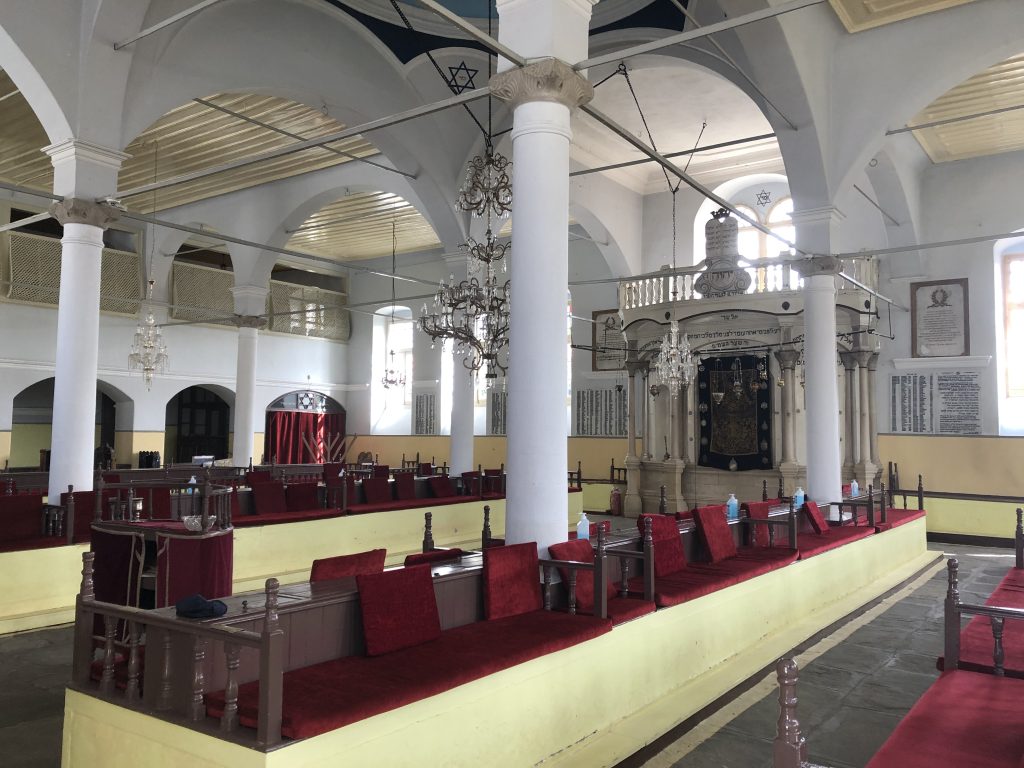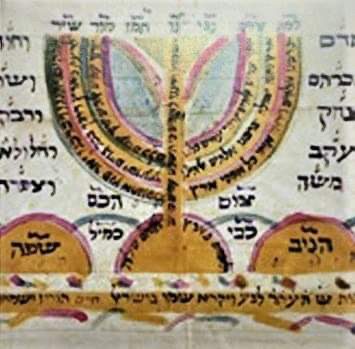Shabbat
Observance of the Sabbath day is one of the most fundamental requirements of Judaism. The Sabbath day is devoted to prayer, study of the Law and abstinence from any form of productive work. Every Friday afternoon the town crier walked through the Jewish neighbourhoods in Ioannina announcing the Time of the Sabbath. Jewish shops shut, women called an end to their domestic chores, the food was ready and candles lit just before sunset. Men made their way to the synagogue and then went home to the Sabbath meal, at which they blessed the wine and wished their children good fortune. On the morning of the Sabbath day a Christian neighbour would light the oil lamp in Jewish homes and bring in burning coals for the brazier in winter months. Weather permitting, the Romaniote Jews of Ioannina would walk along the shore of the lake, otherwise they would congregate in one another’s homes.
Sukkot
Summer ended with Sukkot’. Sukkot, the Feast of Booths which is in October, is called Kalyvia (the Huts) in Ioannina. I marks the forty years that the Children of Israel spent wandering in the desert before coming to the Promised Land. The main custom I that of building a booth, sukkah, out of canes and dry branches in gardens and on verandas. In the grounds around Kahal Kadosh Yashan there was a permanent booth where food was provided for the needy. During the service in the synagogue the congregation was given a small posy, called a lulav, which they then fixed to the mezuzah on the door post. Fruit and flowers were hung from the roof and the family had their meals and said their prayers in the booth they had made.
Rosh Hashanah
Jewish New Year, Rosh Hashanah, is celebrated in September and marks the beginning of the ten days of Repentance or Terrible Days of Yamim Noraim. The ten-day period ends with the Day of Atonement, or Yom Kippur, which Jews of Ioannina call simply Kippur or High Day. A town crier would walk the streets of the Jewish quarter two or three hours before dawn, shouting,
‘Time for Selihot.’
This was how he called the men of the community to the Synagogue at 06.00 for the Prayers of Repentance.
The tashlih, or symbolic depositing of sins in the lake to the accompaniment of rabbinical psalms, is the most dramatised part of Rosh Hashanah celebrations. Christian townspeople of Ioannina often used to attend celebrations of Jewish New Year. Sometimes local officials also came to watch and share the joy of their Jewish fellow citizens.
Hanukkah

Falling in December, Hanukkah celebrates how the Jewish people were saved from Antiochus IV Epiphanes. Jews in Greece associate Hanukkah with the legendary young Jewish woman called Judith, who saved her people from Persian conquest.
In Ioannina, Hanukkah is regarded as a celebration for the home, since that is where all customs pertaining to it take place. The eight-day lighting of the eight-candled Hanukkah lamp takes precedence, each lighting taking place during a family meal. The most popular of the delicious foodstuffs that local housewives prepare are the lallagit pancakes, as local children call them, honey doughnuts and fritters.
Yom Kippur
The Romaniote people of Ioannina developed many customs of their own to mark the Day of Atonement. On the Eve of the Day of Atonement, every family would take one flower-decorated candle to morning service at the synagogue for each male member it had. The candles would stand in the family’s designated place and remain lit throughout the service. Large candles were often taken as votive offerings. This made the synagogues of Ioannina bright and colourful on these days.
Kapparah is one of the most interesting customs associated with Yom Kippur. On the eve of Kippur, every family would sacrifice a cockerel for each male person in it, so as to receive atonement for sins and transgressions.
Irtaman
Irtaman was a holiday of the people and was unique to Ioannina. Irtaman took place two weeks before Purim, in obedience to the Biblical order to double people’s joy in the month of Adar, and was seen as its forerunner. Nearly every boy in the Jewish community between the ages of five and fifteen took part. The boys would take to the streets early in the morning, each with a cloth satchel hung round his neck, and they would weave their way through the city’s Jewish neighbourhoods singing this little song:
We’re here and happy to find you
Now Rishhodesh is here
The Praised and the Lauded
Fifteen days to Purim
And thirty to the belts
Abraham Leto got the cockerel
Muli muli the violet
All nails and horseshoes
To Aman to Arour
To bicotser Yiamim
At the end of the song they would be given treats, which were usually nuts, grain, bread rolls and brioche with a dyed red egg, money or paffles, little tin boxes.
Little Purim
The Romaniote Jewish Community of Ioannina was the only place where Sicilian Purim, also called P(u)r(i)mop(ou)lo in the local dialect, was celebrated until 1954. It fell in January or February and commemorated how the Jews of Syracuse escaped from the humiliation and scheming of king Saragosanos in the early 15th century. All Jews who had roots in Sicily took part in this celebration, thereby making their different origin known. Celebrations mostly took the form of meetings and communal meals. Such was the assimilative ability of the Jews of Ioannina that the legend soon became a folk song.
Come closer, my king,
and listen to my story,
the Jews mock you, and bow in pretence.
They honour you with no learning, and only ask their lives.
His slave Efraim, who worked
for his honour,
and was his right-hand man, E
lia sent as his messenger.
Wake up, Efraim, don’t sleep,
decorate the synagogue and get busy,
and decorate the sefurim, fill the letters,
Decorate them with stars, and tell no one.
They hanged Marko, like a dog.
Praise to God the Almighty, grace
on the Jews to bestow,
And bring out Elia Ηαnavi
for this great day.
Purim
‘Eat, drink till you’re merry, and enjoy yourselves’
Purim is the Jewish carnival, which takes place in March, almost coinciding with the Christian carnival. A time for good cheer and rejoicing for the Jewish people having been saved from the tyranny of Haman, the 5th century BC Persian Vezir’s advisor, thanks to queen Esther’s intervention.
The main features of Purim are fancy dress, parties, dancing, singing and the performance of plays. Groups of children used to roam the streets of Jewish neighbourhoods hoping for Purim treats. The fancy dress costumes worn by young and old were mostly improvised; girls would dress up as Esther and boys as Mordochai or Ahashveros. A mask made of paper or cloth was essential, and dressed like this they would roam the streets and go to school dances and plays which were based on the Biblical story and often written in verse.
Some people copied customs from Christian carnival celebrations, such as the “Gamila” and dancing round the May pole. From 1950 and on, young Jewish women in Ioannina would join in both Purim celebrations and the Christian carnival. Prominent and ordinary Christian townspeople joined Jews in their celebrations at home and in taverns serving wine.
The focal point of celebrations in the homes of Ioannina Jews was the ceremonial reading of the Book of Esther, or the miglah, as the Meggilat Esther was called in local dialect. Until 1940, celebrations would include people telling funny stories parodying sacred passages, and also songs. The best known Purim song is a verse narrative in Greek of the story of Esther. It is called Kina Glossa and has verses of five rhyming lines.
Start to speak o tongue
of miracles unsung
Awaken those who inertly recline,
Make them inebriate with wine.
Housewives made special goodies, such as almond bread in the shape of Haman’s ears, or koubetta, also called sousamato, toffee sesame seed cake, and Haman’s fleas.
Pessah
Pessah is one of the most important celebrations in Judaism and takes place in April. Women undertake the preparations; i.e. thorough cleaning, the best dinner service and other special things related to Pessah. In Ioannina it is customary to sterilise all the ordinary crockery in boiling water. Until World War II all the women of the neighbourhood did this together.
The Eve of Pessah was the time for bedikat hametz when the whole family searched the house from top to bottom to get rid of every crumb of leavened bread. The following morning these crumbs were thrown into the lake while prayers were said asking for forgiveness of sins. Housewives baked their own matzot, or unleavened bread. This was the only kind of bread eaten during the eight days of Pessah. There was a community bakery in Ioannina, which met the needs of the whole community.
Family gatherings were held on the first evening of Pessah, which was known as hova (a derivative of the Hebrew word Hov, meaning duty), and the eldest person there would read the story of the Exodus from Egypt, or Haggadah, in Hebrew and in Greek. On the table there would be a Seder tray or basket full of symbolic foodstuffs like bitter greens, lamb, haroset and eggs dyed with onion skin. At the end of the meal the wish ‘be both a bride and a lady’ was said to girls, and ‘be a bridegroom’ was said to boys.
Shavuot
On Shavuot, which celebrates Moses being given the Tablets with the Ten Commandments, the synagogue in Ioannina, especially the Bima and Ehal were decorated with floral garlands and vases of flowers as a reminder of the flower festival of nature. This is why Turks living in Ioannina called Shavuot the Festival of Flowers or Gioul Bairam. The season that begins with Pessah ends fifty days later with Shavuot. That is why Greek speaking Jews often refer to Shavuot as Pentekosti (Pentecost = fiftiest) probably equating it with the Christian Pentecost.
Source of texts and photos: The Jewish Museum of Greece, https://www.jewishmuseum.gr
